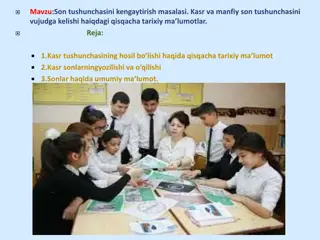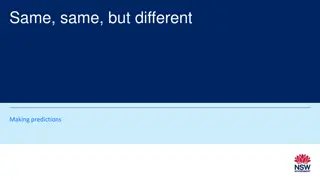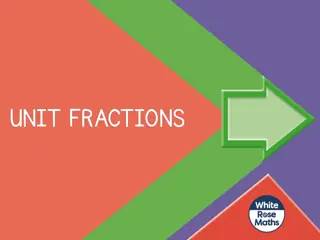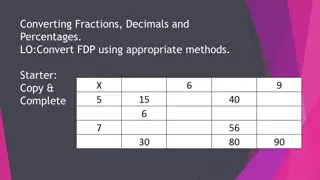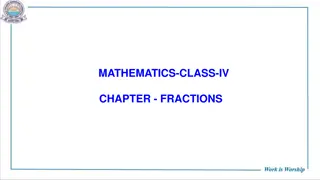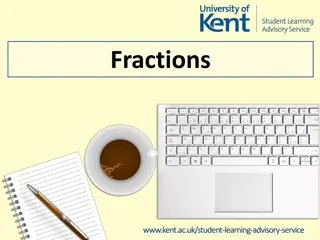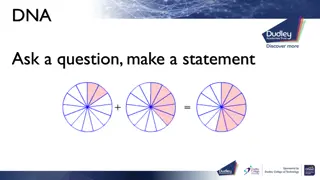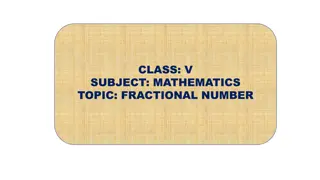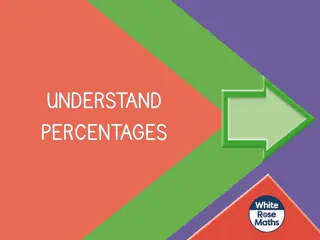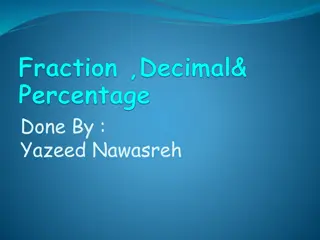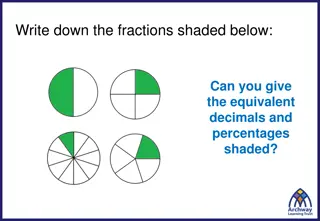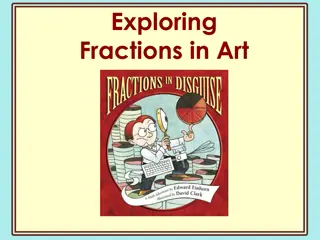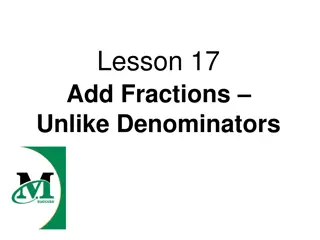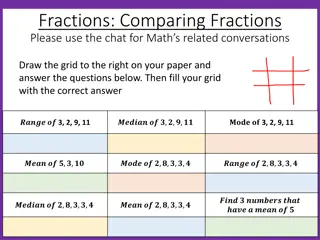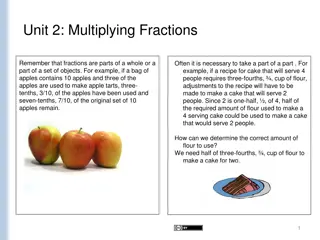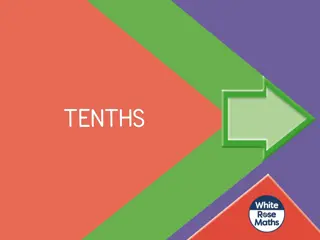
Foundations in Fractional Thinking and Geometry Activities
Explore foundational instruction in fractions and geometry activities for grades K-3, including describing shapes, exploring relationships between parts and wholes, naming relationships, creating equivalents, and more.
Download Presentation

Please find below an Image/Link to download the presentation.
The content on the website is provided AS IS for your information and personal use only. It may not be sold, licensed, or shared on other websites without obtaining consent from the author. If you encounter any issues during the download, it is possible that the publisher has removed the file from their server.
You are allowed to download the files provided on this website for personal or commercial use, subject to the condition that they are used lawfully. All files are the property of their respective owners.
The content on the website is provided AS IS for your information and personal use only. It may not be sold, licensed, or shared on other websites without obtaining consent from the author.
E N D
Presentation Transcript
LAYING THE LAYING THE FOUNDATION: FOUNDATION: FRACTIONS FRACTIONS
You better cut the pizza in four pieces because I'm not hungry enough to eat six. Yogi Berra Inspired by Greg Tang, NCTM Conference, 2012
When does instruction in When does instruction in fractional thinking fractional thinking begin? begin? Formal fraction instructional begins in grade 3, but when does foundational instruction occur?
Instructionally? Instructionally? As you explore the activities, think about how they fit with the KAS in grades K-3? Record your thoughts on the handout.
Fractional foundations Fractional foundations with pattern blocks with pattern blocks Activity 1: Describing, Comparing and Creating Shapes Activity 2: Exploring Relationships between Parts and Wholes Activity 3: Naming Relationships between Parts and Wholes Activity 4: Creating Wholes when Given the Parts Activity 5: Exploring Equivalent Fractions Activity 6: Expressing Whole Numbers as Fractions
Kindergarten Kindergarten Describe and compare measurable attributes K.MD.1: Describe measurable attributes of objects, such as length or weight. Describe several measurable attributes of a single object. K.MD.2: Directly compare two objects with a measurable attribute in common, to see which object has more of / less of the attribute, and describe the difference. For example, directly compare the heights of two children and describe one child as taller/shorter. Analyze, compare, create, and compose shapes. K.G.5: Model shapes in the world by building shapes from components (e.g., sticks and clay balls) and drawing shapes. K.G.6: Compose simple shapes to form larger shapes. For example, Can you join these two triangles with full sides touching to make a rectangle?
st Grade Grade Measure lengths indirectly and by iterating length units. 1.MD.1: Order three objects by length; compare the lengths of two objects indirectly by using a third object. 1.MD.2: Express the length of an object as a whole number of length units, by laying multiple copies of a shorter object (the length unit) end to end; understand that the length measurement of an object is the number of same-size length units that span it with no gaps or overlaps. Limit to contexts where the object being measured is spanned by a whole number of length units with no gaps or overlaps. 1.MD.3: Tell and write time in hours and half-hours using analog and digital clocks. Reason with shapes and their attributes. 1.G.2: Compose two-dimensional shapes (rectangles, squares, trapezoids, triangles, half-circles, and quarter-circles) or three-dimensional shapes (cubes, right rectangular prisms, right circular cones, and right circular cylinders) to create a composite shape, and compose new shapes from the composite shape. (Note: Students do not need to learn formal names such as right rectangular prism. ) 1.G.3: Partition circles and rectangles into two and four equal shares, describe the shares using the words halves, fourths, and quarters, and use the phrases half of, fourth of, and quarter of. Describe the whole as two of, or four of the shares. Understand for these examples that decomposing into more equal shares creates smaller shares. 1 1st
2 2nd Measure and estimate lengths in standard units. 2.MD.2: Measure the length of an object twice, using length units of different lengths for the two measurements; describe how the two measurements relate to the size of the unit chosen. 2.MD.4: Measure to determine how much longer one object is than another, expressing the length difference in terms of a standard length unit. Reason with shapes and their attributes. 2.G.3: Partition circles and rectangles into two, three, or four equal shares, describe the shares using the words halves, thirds, half of, a third of, etc., and describe the whole as two halves, three thirds, four fourths. Recognize that equal shares of identical wholes need not have the same shape. nd Grade Grade
And then And then Develop understanding of fractions as numbers. Note: Grade 3 expectations in this domain are limited to fractions with denominators 2, 3, 4, 6, and 8. 3.NF.1: Understand a fraction 1/b as the quantity formed by 1 part when a whole is partitioned into b equal parts; understand a fraction a/b as the quantity formed by a parts of size 1/b. 3.NF.2: Understand a fraction as a number on the number line; represent fractions on a number line diagram. a. Represent a fraction 1/b on a number line diagram by defining the interval from 0 to 1 as the whole and partitioning it into b equal parts. Recognize that each part has size 1/b and that the endpoint of the part based at 0 locates the number 1/b on the number line. b. Represent a fraction a/b on a number line diagram by marking off a lengths 1/b from 0. Recognize that the resulting interval has size a/b and that its endpoint locates the number a/b on the number line. 3.NF.3:Explain equivalence of fractions in special cases, and compare fractions by reasoning about their size. a. Understand two fractions as equivalent (equal) if they are the same size, or the same point on a number line. b. Recognize and generate simple equivalent fractions, e.g., 1/2 = 2/4, 4/6 = 2/3). Explain why the fractions are equivalent, e.g., by using a visual fraction model. c. Express whole numbers as fractions, and recognize fractions that are equivalent to whole numbers. Examples: Express 3 in the form 3 = 3/1; recognize that 6/1 = 6; locate 4/4 and 1 at the same point of a number line diagram. d. Compare two fractions with the same numerator or the same denominator by reasoning about their size. Recognize that comparisons are valid only when the two fractions refer to the same whole. Record the results of comparisons with the symbols >, =, or <, and justify the conclusions, e.g., by using a visual fraction model.
Fractional foundations Fractional foundations with pattern blocks with pattern blocks Activity 1: Describing, Comparing and Creating Shapes Activity 2: Exploring Relationships between Parts and Wholes Activity 3: Naming Relationships between Parts and Wholes Activity 4: Creating Wholes when Given the Parts Activity 5: Exploring Equivalent Fractions Activity 6: Expressing Whole Numbers as Fractions
FOOD FOR THOUGHT FOOD FOR THOUGHT How does your school s curriculum support the development of foundational mathematical knowledge?
REFLECTION REFLECTION

